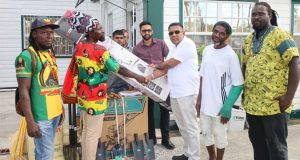SAN JUAN, Puerto Rico CMC – The United States Drug Enforcement Agency (DEA) has warned about increased drug trafficking in the Caribbean, saying that more cocaine is being smuggled into the United States after passing through the region.
The DEA said the heightened trafficking represents a major shift in the route after the region was largely abandoned decades ago.
The agency said 14 percent of cocaine bound for the United States was trafficked through the Caribbean in the first half of this year, doubling the 7 percent that came through the region during the corresponding period last year.
“What we’re seeing is that traffickers are increasing the amount of cocaine in each” shipment, said Vito S. Guarino, special agent in charge of the DEA’s Caribbean division.
“This is a shift toward the Caribbean,” he told reporters. “And the picture we’re looking at right now will be the picture for the next few years.”
In this light, the FBI said it had dismantled one of the most powerful gangs to operate in the Caribbean over the past two decades.
The law enforcement agency said the Puerto Rico-based drug trafficking group allegedly moved drugs from the Dominican Republic to users in the US, earning more than US$100 million along the way. Twenty-seven suspects were arrested.
Daurius Figueira, a Trinidad and Tobago-based researcher and author of Cocaine Trafficking in the Caribbean and West Africa in the Era of the Mexican Cartel, said criminal organizations are “establishing a series of trafficking points in the Caribbean to move products both to North America and to Europe — directly or via West Africa.”
“In the Caribbean, there have been two strategies in response: The first is total denial and suppression of reality,” he told the Miami Herald. “The second is to simply sit and wait for their territory to be ‘switched on.’ ”
Last month, William R. Brownfield, assistant secretary of state for international narcotics and law enforcement affairs, said the Caribbean trafficking corridor of the 1970s and 1980s is “still around and will begin to look more attractive” to criminal organizations as they search for an alternative to Central America and Mexico.
According to the DEA, the Dominican Republic — regarded as the largest transshipment point in the Caribbean — received 27 metric tons of cocaine in 2013, an increase from 22 tons a year earlier.
The increase in the Caribbean came even amid an overall drop in the amount of cocaine shipped in the hemisphere, suggesting smugglers are confident they can take advantage of weak security in the region, the Herald said.
Guarino said South American and Mexican criminal groups are using the Caribbean’s largely unguarded coasts as landing points for high-speed boats carrying bundles of cocaine.
Once on land, he said the drugs are moved on to the United States and Europe through shipping containers, mules (drug-carrying individuals) or by boat through Puerto Rico.
“We’re starting to see 1,000-kilo [2,200-pound] loads off the coast of Puerto Rico and the US Virgin Islands,” he said. “It suggests that, the capability to move those size shipments is there, and the [traffickers] are more confident.”
The DEA said agents in the Caribbean and Bogotá, Colombia have “intelligence obtained throughout numerous investigations [indicating] that go-fast vessels departing Venezuela and Colombia were heading straight to Puerto Rico and Haiti.”
The US federal government has already increased aid to the region, providing military training and other assistance, such as tracking drug boats by radar from Key West, Florida, the Herald said.
In 2010, Washington launched the Caribbean Basin Security Initiative, which dedicates at least US$200 million to Caribbean countries over three years to fight drug trafficking.
 Pride News Canada's Leader In African Canadian & Caribbean News, Views & Lifestyle
Pride News Canada's Leader In African Canadian & Caribbean News, Views & Lifestyle




